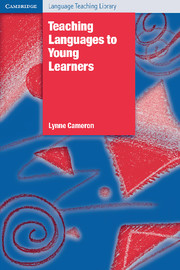Book contents
- Frontmatter
- Contents
- Preface
- Acknowledgements
- 1 Children learning a foreign language
- 2 Learning language through tasks and activities
- 3 Learning the spoken language
- 4 Learning words
- 5 Learning grammar
- 6 Learning literacy skills
- 7 Learning through stories
- 8 Theme-based teaching and learning
- 9 Language choice and language learning
- 10 Assessment and language learning
- 11 Issues around teaching children a foreign language
- References
- Index
7 - Learning through stories
Published online by Cambridge University Press: 05 May 2010
- Frontmatter
- Contents
- Preface
- Acknowledgements
- 1 Children learning a foreign language
- 2 Learning language through tasks and activities
- 3 Learning the spoken language
- 4 Learning words
- 5 Learning grammar
- 6 Learning literacy skills
- 7 Learning through stories
- 8 Theme-based teaching and learning
- 9 Language choice and language learning
- 10 Assessment and language learning
- 11 Issues around teaching children a foreign language
- References
- Index
Summary
Stories and themes as holistic approaches to language teaching and learning
Stories and themes are placed together in this chapter and the next because they represent holistic approaches to language teaching and learning that place a high premium on children's involvement with rich, authentic uses of the foreign language. Stories offer a whole imaginary world, created by language, that children can enter and enjoy, learning language as they go. Themes begin from an overarching topic or idea that can branch out in many different directions, allowing children to pursue personal interests through the foreign language.
Exploring the use of stories and themes will allow us to re-visit the principles and approaches of earlier chapters, as we work through the possibilities and opportunities they offer. The approach in this book has been underpinned by the principle that children and their learning can guide teaching; in particular, I have tried to show how directions for teaching can emerge from the dynamic interplay between possible tasks, activities, and materials, on the one hand, and children's desire to find and construct coherence and meaning, on the other. When we have looked in previous chapters at aspects of the foreign language, task content and materials have been designed for the classroom. As we move now to stories and themes, we start from materials and content that have a more independent existence beyond the classroom.
- Type
- Chapter
- Information
- Teaching Languages to Young Learners , pp. 159 - 179Publisher: Cambridge University PressPrint publication year: 2001

